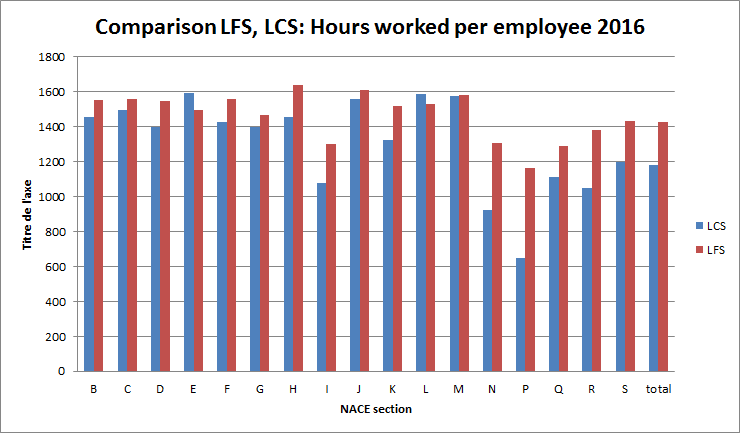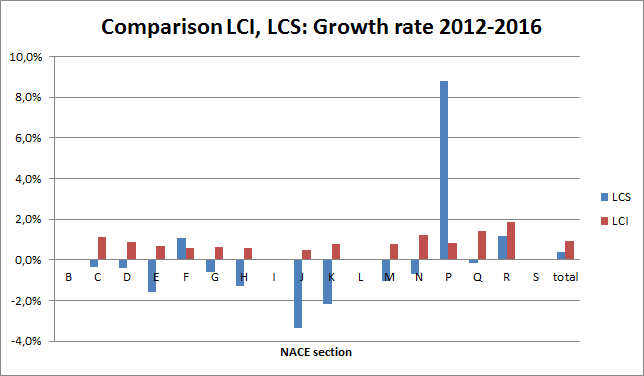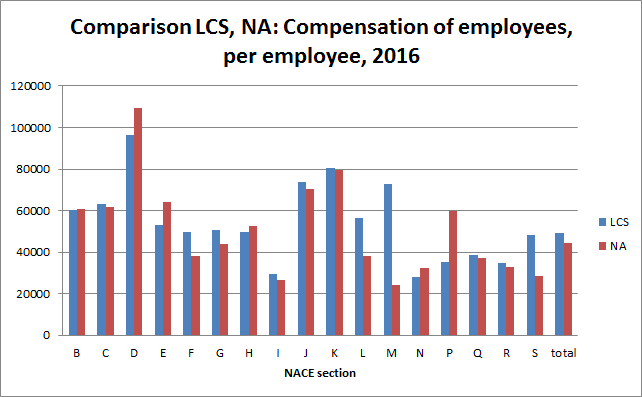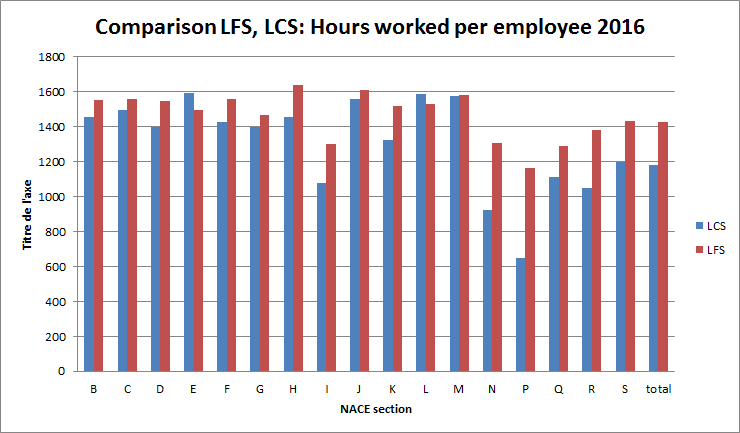 |
|
 |
|
| For any question on data and metadata, please contact: Eurostat user support |
|
|||
| 1.1. Contact organisation | Federal Public Service (FPS) Economy, SMEs, Self-employed and Energy Statistics Belgium |
||
| 1.2. Contact organisation unit | Thematic Department "Society" |
||
| 1.5. Contact mail address | NG III – 6th floor Boulevard du Roi Albert II, 16 1000 Brussels Belgium |
||
|
|||
| 2.1. Data description | |||
The four-yearly labour cost survey meets the statistical needs of the Commission as defined in the Council Regulation (EC) No 530/1999 of 9 March 1999 and the Commission Regulation (EC) No 1737/2005 of 21 October 2005. This four-yearly survey is based on a sample of local units of enterprises with at least 10 employees. The data are collected according to the activity and location of the local unit, as well as the size of the enterprise to which the local unit belongs. The labour cost survey is organised every four years. |
|||
| 2.2. Classification system | |||
NACE Rev 2.
|
|||
| 2.3. Coverage - sector | |||
NACE Rev 2 sections B-S except O |
|||
| 2.4. Statistical concepts and definitions | |||
In line with the Council Regulation (EC) No 530/1999 of 9 March 1999 and the Commission Regulation (EC) No 1737/2005 of 21 October 2005. |
|||
| 2.5. Statistical unit | |||
enterprises and respective local units |
|||
| 2.6. Statistical population | |||
enterprises with at least 10 employees |
|||
| 2.7. Reference area | |||
Belgium |
|||
| 2.8. Coverage - Time | |||
2016 |
|||
| 2.9. Base period | |||
not applicable |
|||
|
|||
- |
|||
| 3.1. Source data | |||
In 2016, the four-yearly survey on labour cost is based on the exclusive use of administrative sources (NSSO, NBB, FPS Finances, etc.). Before 2016, the survey was based on a sample of local units of enterprises with at least 10 employees, selected in the NSSO(PLA) registers. Therefore, the comparison with the results prior to 2016 should be made with a great deal of caution. Data from the NSSO (National Social Security Office) are used in the estimates for the number of employees (A), the hours actually worked (B), the paid hours (C), the direct remuneration, bonuses and allowances (D1111), the payments for days not worked (D1113), the company cars (D11143) and the statutory social-security contributions (D1211). Data from the NBB (National Bank of Belgium) on the annual accounts of enterprises are used to estimate the collectively agreed, contractual and voluntary social-security contributions (D1212). Data from the FPS (Federal Public Service) Finances on personal income tax (BELCOTAX) and on corporate tax (BIZTAX) are used to estimate payments to employees’ savings schemes (D1112), wages and salaries in kind (D1114), employers' imputed social contributions (D122), other expenditure (D3) and subsidies (D5). The estimate of vocational training costs (D2) is based on the indexed results of the Continuing Vocational Training Survey (CVTS) for the year 2015. |
|||
| 3.2. Frequency of data collection | |||
every 4 years |
|||
| 3.3. Data collection | |||
Based on legal authorisation, administrative data are received electronically from their institution. NSSO data have arrived 16 months after the reference period (April 2018), as the NSSO and the SSSSO (former NSSOPLA) have merged their services since 01/01/2017. The data integration from both former organisations has taken more time than expected. NBB data are delivered 10 days after their receipt at the Central Balance Sheet Office. As a reminder, enterprises have to submit their annual accounts within 6 months after the closure of the financial year. FPS Finances data are delivered 6 months after the reference period for BELCOTAX and 12 months after the reference period for BIZTAX. Data from CVTS 2015 were delivered on 22/09/2017 after the publication of the survey results on Statbel's website (on 20/09/2017). |
|||
| 3.4. Data validation | |||
not requested |
|||
| 3.5. Data compilation | |||
Done by Belgium statistical institute. |
|||
| 3.6. Adjustment | |||
not applicable. |
|||
|
|||
| 4.1. Quality assurance | |||
|
|||
| 4.2. Quality management - assessment | |||
Following the very negative diagnosis of LCS 2012 (low response rate, inconsistencies between sources), it was decided to launch a reform of LCS 2016 that would be based on the exclusive use of administrative sources. This project, started in 2015 and funded by a Eurostat's grant over the period 2015-2017, involved two steps: 1) the collection of administrative sources not yet available, 2) the construction of LCS 2016 variables using a comparative analysis of the results obtained in 2012 between the alternative sources and the LCS data. The results of the second step are relatively satisfying for the main variables studied, i.e. the selection variables (enterprise size, NACE section and region of the local unit), the number of employees (A), the hours paid (C), and the survey variables which represent 95 % of the labour cost according to LCS 2012 (direct remuneration, bonuses and allowances, payments for days not worked and statutory social-security contributions). However, a new reform project on LCS, for the year 2020 this time, will be launched in 2019 in order to further improve the current method for estimating the number of apprentices (A13), the hours actually worked (B) and the subsidies received by the employer (D5).
|
|||
|
|||
- |
|||
| 5.1. Relevance - User Needs | |||
The main users of the results of the Labour Cost Survey (LCS) are Eurostat, the Ministry of Economy/Statistics Belgium, the Ministry of Employment, Labour and Social Dialogue, the National Bank of Belgium, the Central Economic Council, employers associations, trade unions, the media, universities, students and enterprises. The Labour Cost Survey contains variables that are not available in other statistics. In administrative data (e.g. files from the National Social Security Office and the National Bank of Belgium) variables are not even available at the level of local units. This survey creates data that are compnsuchrasarable with other European countries. |
|||
| 5.2. Relevance - User Satisfaction | |||
The needs of national users have been satisfied. |
|||
| 5.3. Completeness | |||
The LCS 2020 reform, that will be launched in 2019, provides that the survey will be extended to local units of enterprises with less than 10 employees and to local units in the NACE sector O "public administration". |
|||
| 5.3.1. Data completeness - rate | |||
[Not requested] |
|||
|
|||
- |
|||
| 6.1. Accuracy - overall | |||
[Not requested] |
|||
| 6.2. Sampling error | |||
No survey |
|||
| 6.2.1. Sampling error - indicators | |||
No survey |
|||
| 6.3. Non-sampling error | |||
The Labour Cost survey contains variables that are not identified or poorly covered in the administrative sources available (NSSO, NBB, Belcotax and BIZTAX): the number of apprentices (A13); the hours actually worked (B), the payments for days not worked (D1113), the collectively agreed, contractual and voluntary social-security contributions (D1212), the vocational training costs (D2), the other expenditure paid by the employer (D3), the taxes (D4) and the subsidies received by the employer (D5).
|
|||
| 6.3.1. Coverage error | |||
The number of apprentices (A13) is estimated based on NSSO data that make it possible to identify apprentices younger than 19 only. Older apprentices are incorporated into the numbers of other employees (A11 and A12). Hours actually worked (B) are reported in the NBB's social balance sheets, but only enterprises with at least 20 full-time equivalents (FTE) have an obligation to publish them at the Central Balance Sheet Office. Payments for days not worked (D1113) are largely recorded in the NSSO sources as a direct remuneration (D1111). Vocational training costs (D2) are estimated based on the CVTS survey that covers the year 2015 and not 2016. Other expenditure paid by the employer (D3) are recorded in BIZTAX only if they can be deducted from corporate tax, which is not the case for many of them. Taxes (D4) that are considered as labour costs are difficult to identify as the employment policies in place at the federal and local levels aim to promote job creation rather than discourage it. However, some local units have reported this type of cost in the LCS 2012 (0.2 % of the responding local units). So this should correspond to very specific taxes and be limited to few municipalities. Unfortunately, they cannot be identified by means of the available tax administrative sources. Subsidies received by the employer (D5) cannot, for the most part, be found in the administrative sources available. Reductions in social security contributions are provided by the NSSO, as well as the exemptions on personal income tax (BELCOTAX) and on corporate tax (BIZTAX), but many of these employment aid measures are also paid by regional or local organisations whose data are not yet available. . |
|||
| 6.3.1.1. Over-coverage - rate | |||
There is over-coverage error for the variables A11 and A12 with older apprentices and for the variable on direct remuneration (D1111) where the most of payments for days not worked (D1113) are recorded. The problems are above all on under-coverage errors (see 6.3.1). |
|||
| 6.3.1.2. Common units - proportion | |||
[Not requested] |
|||
| 6.3.2. Measurement error | |||
All enterprises have the legal obligation to report the information asked at NSSO and tax authorities (BELCOTAX and BIZTAX). Moreover, this information is regularly checked by these authorities. However, these checks are less meticulous at the level of the NBB's social balance sheets for which many values seem to be outliers. |
|||
| 6.3.3. Non response error | |||
No survey |
|||
| 6.3.3.1. Unit non-response - rate | |||
[Not requested] |
|||
| 6.3.3.2. Item non-response - rate | |||
[Not requested] |
|||
| 6.3.4. Processing error | |||
The estimate of vocational training costs is based on CVTS which surveyed, in 2015, the Belgian enterprises with at least 10 employees in the activity sectors B to N and R to S, excluding the non-market sectors O, P and Q. The non-response rate of CVTS 2015 varies between 11.5 % and 14.5 % for the variables on vocational training cost. The presence of outliers and missing values for these variables has also required the use of imputation models (with an imputation rate of 11.2 %). |
|||
| 6.3.4.1. Imputation - rate | |||
The variables used in CVTS 2015 have an imputation rate of 11.2%. |
|||
| 6.3.5. Model assumption error | |||
Three model types have been used to estimate the LCS 2016 variables: - 1) the models of microdata use, with the bottom-up approach; - 2) the models of microdata use, with the top-down approach; - 3) the imputation models with aggregated data. The bottom-up models use data at the level of employees to aggregate them at the level of local units. NSSO and BELCOTAX data on employees allow this type of use. NSSO data are even more detailed, because the registration unit is the occupation line (or contract line), which make it possible to make accurate estimates on a monthly basis, and not only on a quarterly basis. Moreover, this information is regularly checked by these authorities. These estimation models generate good quality results. Most variables are produced based on these models: the number of employees (A), the paid hours (C) and the survey variables that represent 95 % of the labour cost according to LCS 2012 (direct remuneration, bonuses and allowances, payments for days not worked and statutory social-security contributions). The top-down models use data at the level of enterprises to disaggregate them at the level of local units. NBB and BIZTAX data make this type of use possible. The disadvantage of these models is that the use of the top-down approach requires to spread the labour costs according to the number of employees in the local unit, with the false assumption that all employees of the enterprise have the same costs. Several variables are produced based on these models: payments to employees’ savings schemes (D1112), wages and salaries in kind (D1114), collectively agreed, contractual and voluntary social-security contributions (D1212) and employers' imputed social contributions (D122). The imputation models with aggregated data consist of the application to local units or enterprises identified at NSSO aggregated data from another statistical source. Several variables are produced based on these models. Hours actually worked (B) are imputed by applying to local units' paid hours the coefficients observed in LCS 2012 between the hours worked (B) and paid (C) according to the NACE sectors and the categories of employees (full-time and part-time). Working hours reported in the NBB's social balance sheets have been deemed of insufficient quality to be used. Vocational training costs (D2) are imputed by applying to enterprises the amounts estimated in 2015 and indexed for 2016 from CVTS according to the NACE sector and the size of the enterprise. The amounts obtained per enterprise are then spread according to the local units based on a top-down model with a distribution according to the number of employees per local unit. For the other expenditure paid by the employer (D3), taxes (D4) and subsidies received by the employer (D5), the estimates obtained with the sources available give insufficient amounts, particularly compared to the results of LCS 2012. Consequently, extra amounts have been implemented and added to the initial estimates. For this, the differences between the estimates obtained in 2016 and in LCS 2012 have been calculated, and then divided by the number of employees according to the NACE sector and the size of the enterprise. The extra amounts are then obtained by applying to local units' staff the differences calculated by employee according to the NACE sector and the size of the enterprise. |
|||
| 6.4. Seasonal adjustment | |||
[Not requested] |
|||
| 6.5. Data revision - policy | |||
[Not requested] |
|||
| 6.6. Data revision - practice | |||
[Not requested] |
|||
| 6.6.1. Data revision - average size | |||
[Not requested] |
|||
|
|||
- |
|||
| 7.1. Timeliness | |||
The four tables with the completely controlled and internally approved data were sent to Eurostat on 9 July 2018. Afterwards several versions were produced to respond to the Eurostat validation procedures. The latest version dates from 8th November 2018. All these revisions have only affected the structure of the files and not their content. |
|||
| 7.1.1. Time lag - first result | |||
[Not requested] |
|||
| 7.1.2. Time lag - final result | |||
[Not requested] |
|||
| 7.2. Punctuality | |||
The legal authorisations for the use of administrative data from the NSSO and the FPS Finances (Belcotax and Biztax) have been granted in 2016. The development of the models of data use has started as soon as the administrative data for the year 2012 were received in 2016 and 2017. The production of the results for the year 2016 has started with the delivery of NSSO data in April 2018 based on the use models developed over the period 2016-2018. The results were finally published on our website in October 2018. |
|||
| 7.2.1. Punctuality - delivery and publication | |||
[Not requested] |
|||
|
|||
- - |
|||
| 8.1. Comparability - geographical | |||
Definition of the local unit: Definition of the local unit according to Council Regulation N° 696/93: The local unit is an enterprise or part thereof (e. g. a workshop, factory, warehouse, office, mine or depot) situated in a geographically identified place. At or from this place economic activity is carried out for which — save for certain exceptions — one or more persons work (even if only parttime) for one and the same enterprise. The law of 16 July 2003 on the creation of a national register of enterprises: An establishment unit is any place that one can identify a geographical address, where at least one activity of the company is exercised or where the business is conducted. Definition of the local unit by the N.S.S.O., the N.B.B and the F.P.S. Finances : They use the same definition as the national register of enterprises. |
|||
| 8.1.1. Asymmetry for mirror flow statistics - coefficient | |||
[Not requested] |
|||
| 8.2. Comparability - over time | |||
The shift from a survey on local units in 2012 to an exclusive use of administrative sources in 2016 necessarily implies differences in the results between the two methods. The main difference is that the use of more detailed data at the level of employees' occupation lines from the NSSO made it possible to use a monthly average for the estimate of the number of employees (instead of a quarterly average in 2012). This change in method made it possible to include employees with short-term employment contracts (at least one quarter). This largely explains the sharp increases of the number of employees for the NACE sectors N (Administrative and support service activities, +41 %) with temporary agency workers and P (Education, +44 %) with external actors, searchers etc.
|
|||
| 8.2.1. Length of comparable time series | |||
[Not requested] |
|||
| 8.3. Coherence - cross domain | |||
Comparison of LCS and LFS: Hours worked per employee LFS only contains information on the hours worked per week. To calculate the hours per year, we multiplied the hours per week by 52 weeks, minus the summer vacation period (circa 4 weeks) and public holidays (circa 2 weeks). This variable is still overestimated because other absence days are not taken into account, e.g. absence due to sickness, maternity leave, … This can explain the divergence between LCS and LFS. Unlike LCS, for sector N, LFS distributes temporary agency workers according to the NACE sector of the enterprise that employs them. For sector P, non-declared hours worked by teachers to the Community to prepare classes and correct exams of students are not taken into account in the 2016 LCS. Comparison LFS, LCS: Hours worked
Growth rate of LCI and LCS: growth rate between 2012 and 2016 The total growth rates of LCI and LCS are almost similar. The main difference is for the sector P (Education) where the new method allows the integration of employees with short-term contracts (searchers, external actors...) who have higher hourly labor costs. The growth rate is not calculated for the sectors B, I, L and S because the results in 2012 LCS were not significant. Comparison LCI, LCS : Growth rate
Comparison LCS, SBS: Wages and Salaries per employee (D11) SBS uses enterprises as statistical unit while LCS is based on local units. Comparison SBS, LCS : Wages and salaries per employee
[Not requested] |
|||
| 8.4. Coherence - sub annual and annual statistics | |||
[Not requested] |
|||
| 8.5. Coherence - National Accounts | |||
Comparison LCS, NA: Compensation of employees, per employee, 2016 (ESA 2010) The difference between LCS and NA can be explained by the use of different sources. NA covers all enterprise sizes and adjusts the figures in order to accurately reflect the entire economy Comparison NA, LCS : Compensation of employees
|
|||
| 8.6. Coherence - internal | |||
[Not requested] |
|||
|
|||
- |
|||
| 9.1. Dissemination format - News release | |||
[Not requested] |
|||
| 9.2. Dissemination format - Publications | |||
The website (https://statbel.fgov.be/fr/themes/emploi-formation/salaires-et-cout-de-la-main-doeuvre/cout-de-la-main-doeuvre) contains a press release, detailed information on the most frequently asked aggregated tables and the methodology. The informations are available in two languages: French and Dutch.
|
|||
| 9.3. Dissemination format - online database | |||
Not planned yet. |
|||
| 9.3.1. Data tables - consultations | |||
[Not requested] |
|||
| 9.4. Dissemination format - microdata access | |||
[Not requested] |
|||
| 9.5. Dissemination format - other | |||
For users who need more detailed and unique data, Statistics Belgium can produce aggregated tables according to user preference. |
|||
| 9.6. Documentation on methodology | |||
Detailed informations with the main methodological aspects and definitions can be found on our website (https://statbel.fgov.be/fr/themes/emploi-formation/salaires-et-cout-de-la-main-doeuvre/cout-de-la-main-doeuvre). |
|||
| 9.7. Quality management - documentation | |||
[Not requested] |
|||
| 9.7.1. Metadata completeness - rate | |||
[Not requested] |
|||
| 9.7.2. Metadata - consultations | |||
[Not requested] |
|||
|
|||
[Not requested] |
|||
|
|||
- |
|||
| 11.1. Confidentiality - policy | |||
[Not requested] |
|||
| 11.2. Confidentiality - data treatment | |||
[Not requested] |
|||
|
|||
With the exclusive use of administrative data, the quality of the results has improved significantly. Nevertheless, improvements are still necessary for some variables: apprentices (A13, B13, C13, D112, D123), hours actually worked (B), payments for days not worked (D1113) and subsidies received by the employer (D5). This will be the subject of a reform project for LCS 2020, in which local units from sector O (Public administration) and enterprises will less than 10 employees will be added. |
|||
|
|||
|
|||



